An epic guitar riff can completely transform a song 一 it instantly hooks listeners, adds dynamic energy, and drives the rhythm forward.
I mean, entire generations have been influenced by them, and they’ve become the heart of some of the most iconic rock songs ever.
As producers, knowing how to work with guitar riffs, regardless of genre (e.g., rock, blues, pop music, or even hip-hop) can completely change the game, for real.
That’s why I’m breaking down everything you need to know about what is a riff in music so you can master them, like:
- What is a riff in music ✓
- The anatomy of a guitar riff ✓
- The difference between a riff and a melody ✓
- Essential guitar riff techniques ✓
- Music theory essentials (no music theory experience needed) ✓
- Expert tips for working with guitar riffs digitally ✓
- Layering techniques for virtual guitars ✓
- Using effects to enhance your guitar riffs ✓
- Integrating riffs into many songs ✓
- Digital tools for laying down guitar riffs ✓
- The top 9 best guitar riffs in history ✓
- Much more about what is a riff in music ✓
After today’s article, you’ll have a super solid understanding about what makes guitar riffs so addicting.
Plus how to use them creatively in your own tracks (and even recreate the classics!).
And, as a special bonus, you’ll also find out the top 9 most legendary guitar riffs throughout music history and learn how they’ve stood the test of time.
Table of Contents
- What is a Riff in Music Exactly?
- The Anatomy of a Guitar Riff
- The Difference Between a Riff and a Melody
- Common Guitar Riff Techniques (For Guitar Players)
- Expert Tips for Working with Guitar Riffs Digitally
- The 9 Best Guitar Riffs in History
- #1. “Smoke on the Water” by Deep Purple
- #2. “Sweet Child O’ Mine” by Guns N’ Roses
- #3. “Smells Like Teen Spirit” by Nirvana
- #4. “Enter Sandman” by Metallica
- #5. “Mannish Boy” by Muddy Waters
- #6. “Seven Nation Army” by The White Stripes
- #7. “Satisfaction” by The Rolling Stones
- #8. “Whole Lotta Love” by Led Zeppelin
- #9. “Rebel Rebel” by David Bowie
- What is a Riff in Music: Final Thoughts
What is a Riff in Music Exactly?
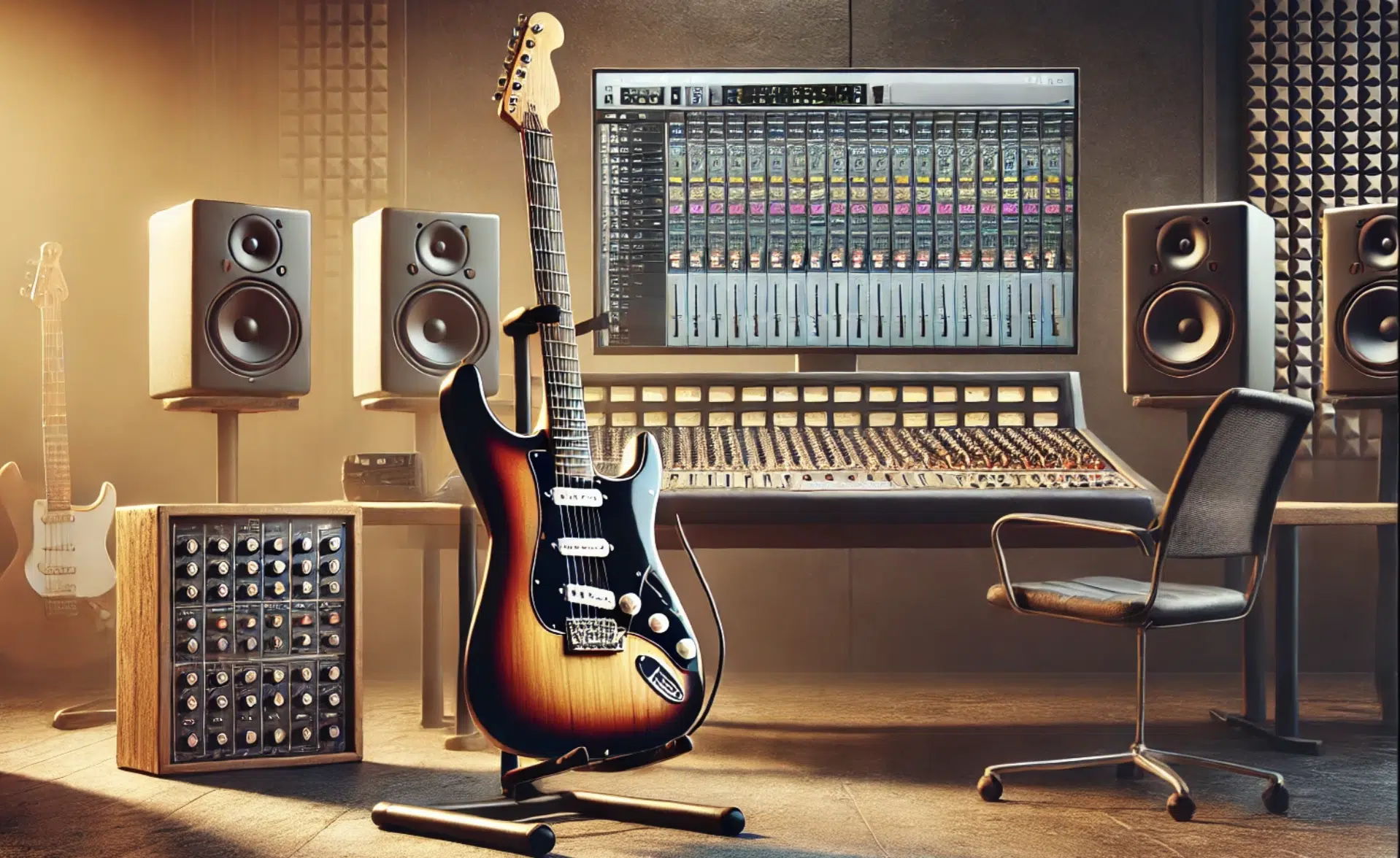
To put it simply, a riff in music is a short, repeated sequence of notes or chords that forms the backbone of a song.
It’s typically a guitar riff that’s instantly recognizable and sets the tone for an entire track to be based around.
Unlike melodies, riffs are often more rhythmically driven and tend to be repeated multiple times throughout a song with little to no variation.
Riffs can be played by different instruments, but they are most commonly associated with guitar, especially if we’re talking rock music.
In some cases, a bass riff can carry the groove in a track 一 creating that infectious rhythm that sticks in your head for days and days (sometimes annoyingly so).
Some of the most memorable riffs in popular music have defined entire genres, from blues and rock to pop music and even hip-hop.
The Anatomy of a Guitar Riff
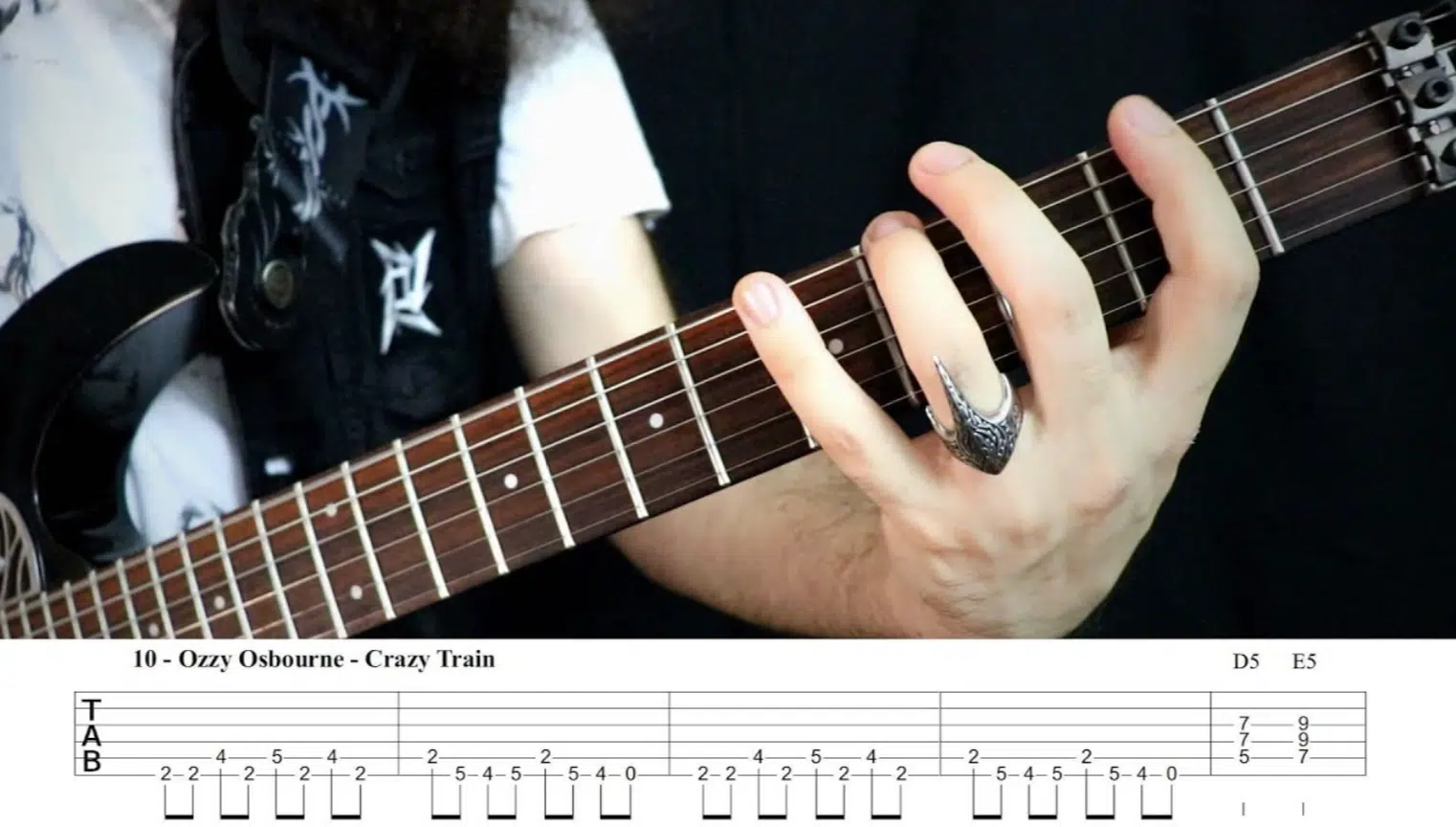
A guitar riff is built on repetition and rhythm, which is why it’s so essential in the foundation of a rock song.
Typically, a riff consists of a few single notes or power chords, played in a repeated pattern to drive the melody forward.
The main guitar riff is often supported by the bass line and drums to create a fuller sound, but the guitar usually takes the spotlight.
For example, in “Smoke on the Water” by Deep Purple (which we’ll break down later on), the repeated riff is simple yet powerful, making it immediately recognizable.
The key to creating a catchy riff, like all the most memorable riffs in history, is focusing on a repeated figure that grabs attention without overcomplicating things.
That’s honestly the beautify of a riff 一 a simple yet super captivating sound that lets you just enjoy it without being all over the place.
The key thing to remember is the best guitar riffs often strike a balance between rhythm and simplicity, which makes them memorable and easy to latch onto.
NOTE: Make sure your guitar riff is not too complex. Stick to 4-8 bar patterns that can be repeated multiple times throughout a track without becoming crazy.
Another key element is to focus on how the riff locks in with the bass line and drums to create a solid rhythmic foundation that fuels the entire track.
But don’t worry, we’ll break everything down in today’s article with an in-depth look at what makes a guitar riff so special.
The Difference Between a Riff and a Melody
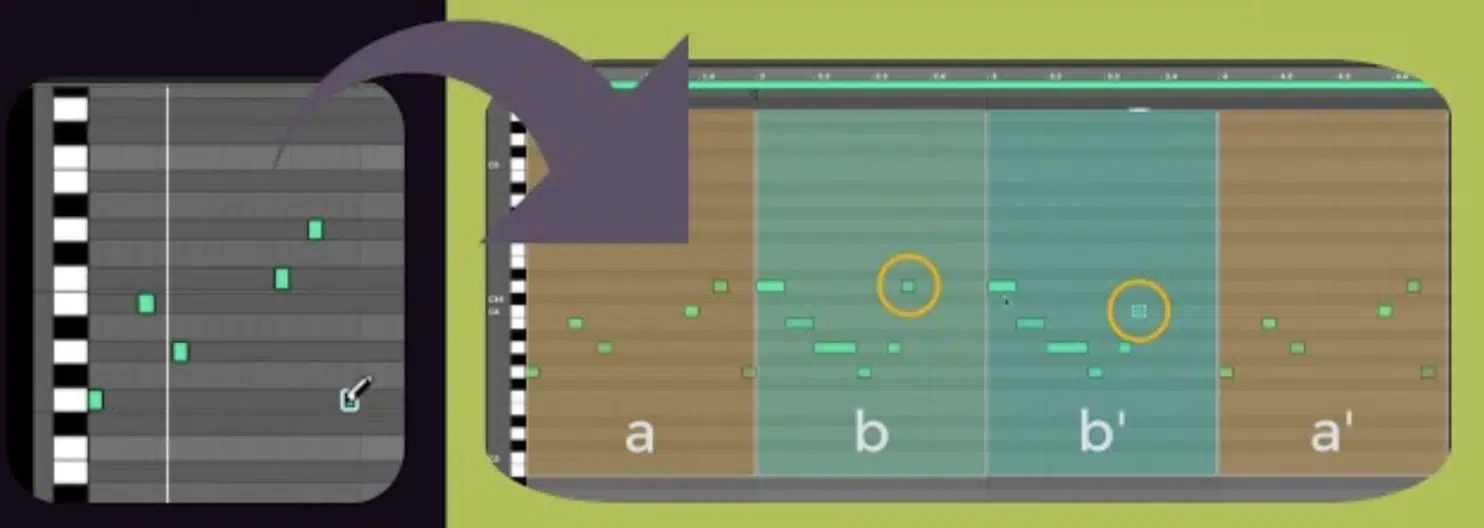
Riff (left); Melody (right)
The biggest question I get when people are learning what is a guitar riff in music is, ‘what’s the difference between a riff and a melody?’
Well, while both riffs and melodies are essential to any song, they serve completely different functions within a track.
A melody tends to be more lyrical and flows with the vocal line or instruments, changing throughout the song to fit the mood and progression perfectly.
They typically involve varied note choices, scales, and phrasing 一 creating a more melodic sound that evolves with each section of the track.
A riff, on the other hand, is typically more repetitive and rhythm-focused, providing the driving force behind the rhythm and groove of the track.
They’re usually made up of short, catchy phrases and really emphasize power chords and simple patterns in order to keep the song’s core energy/hype.
For example, you’ll often hear a riff repeated several times during a verse or chorus, while the melody might change with each song section.
Riffs focus more on rhythm and power chords, while melodies tend to involve more varied note choices and phrasing.
The key difference lies in repetition 一 a melody evolves, while a riff stays consistent to ground the listener, so just make sure to remember that and you’ll be good.
Side note, if you want to learn what a melody is, different melody types, or how to lay down show-stopping melodies, we got you covered.
Common Guitar Riff Techniques (For Guitar Players)
When creating guitar riffs, there are several techniques that come into play, all of which can really shape the feel/flow of a riff in music.
#1. Palm muting
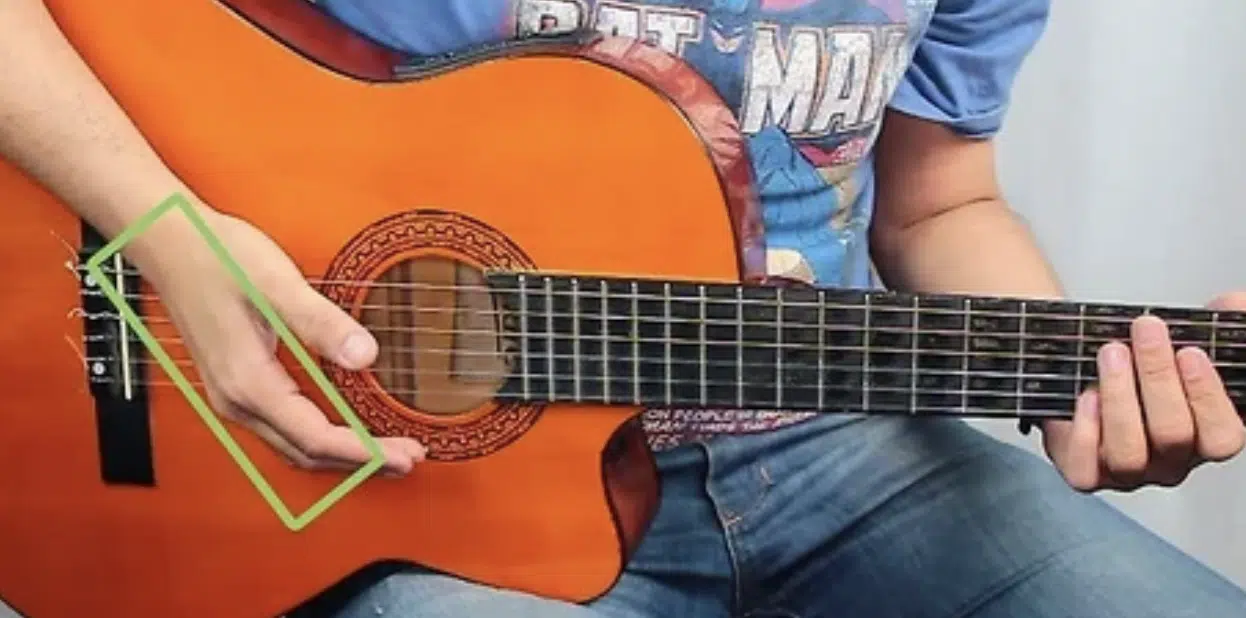
Palm muting is one of the most commonly used techniques, where you lightly rest the edge of your hand on the strings near the bridge to create a muted, punchy sound.
This is great for making your riff more rhythmic and percussive.
You can try using palm muting on every second note of a repeating pattern.
For instance, if you’re playing a repeated sequence of power chords, apply palm muting only on the downbeats to give your riff a tighter, more rhythmic feel.
It really contrasts well with more open, unmuted notes for a dynamic shift that’s super engaging and captivating (plus sounds super professional).
Personally, this is one of my favorite techniques, which was a little complicated for me to learn when I first started playing the guitar, but once you nail it, it’s epic.
#2. Hammer-ons & Pull-offs
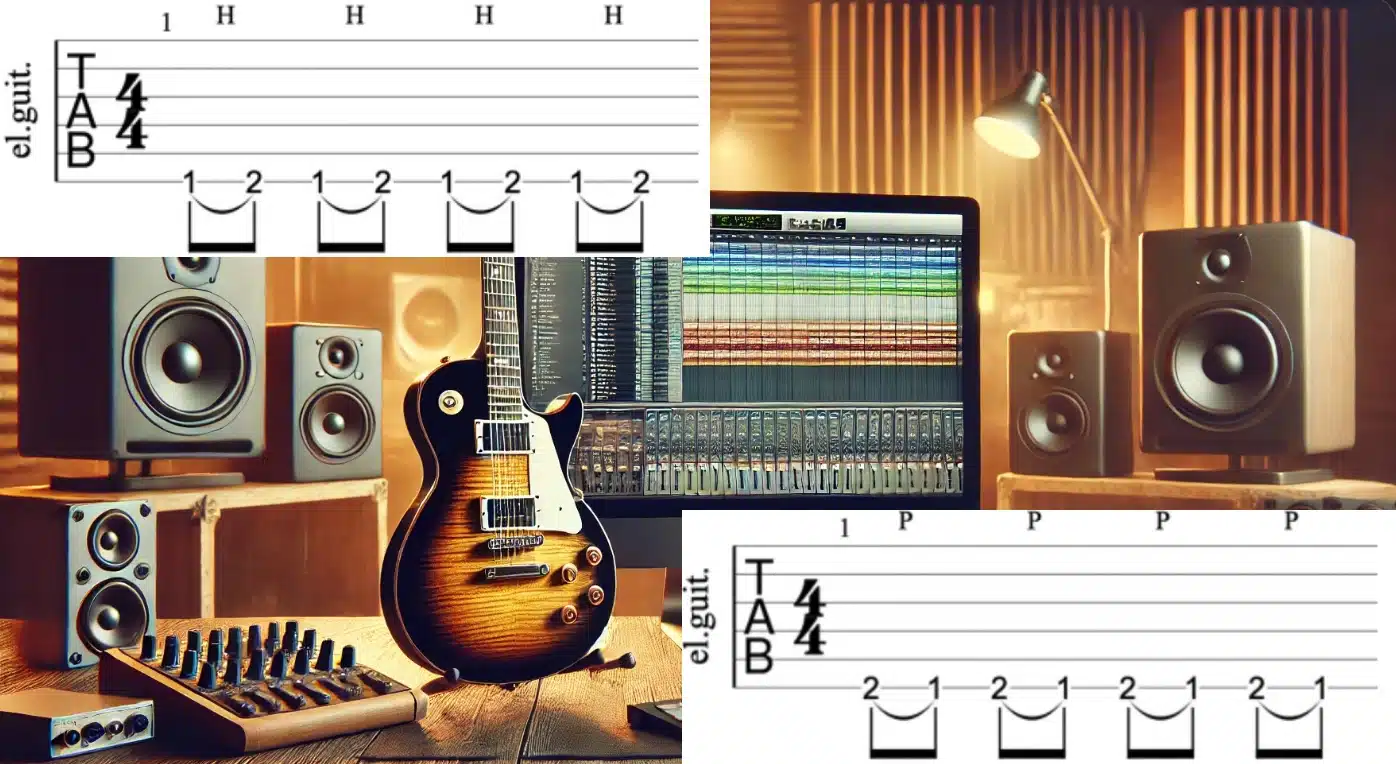
Hammer-ons (top left); Pull-offs (bottom right)
Hammer-ons and pull-offs are other basic/foundational techniques where you play fast, smooth note transitions without picking every note.
Let’s say you’re banging out a melodic run within your guitar riff…
You can move from a low note to a higher note on the same string using hammer-on to create a quick, fluid transition.
This adds a melodic touch to an otherwise rhythmic riff/driving riff and helps fill in the gaps between more percussive parts.
Pro Tip: To make this technique easier, start by practicing on slower tempos and gradually increase the speed to make sure each note rings clearly.
Like anything else, it’ll take practice to master, but it really sounds awesome.
#3. Slides
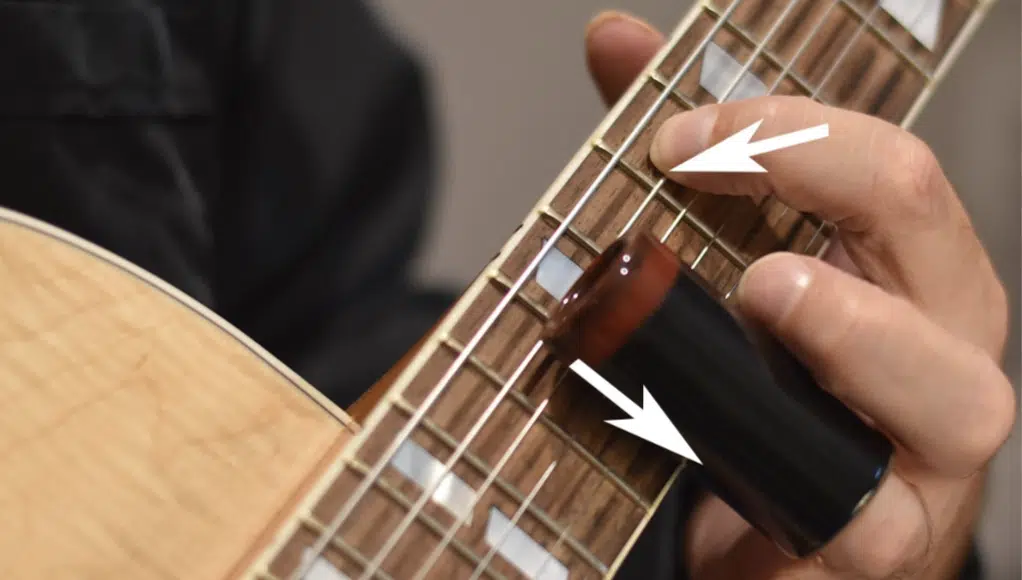
Slides are also used to transition between notes flawlessly by moving your finger along the fretboard 一 adding a unique melodic quality.
In my experience using slides when moving between single notes within the riff is super beneficial, especially when shifting to higher frets.
For example, if you’re moving from the 5th fret to the 9th fret on the same string, use a slide to maintain momentum and create a melodic flow.
This can make the guitar riff feel more fluid and connected 一 adding a unique, expressive quality that’s both beautifully melodic and rhythmic.
#4. Power Chords with Single Notes
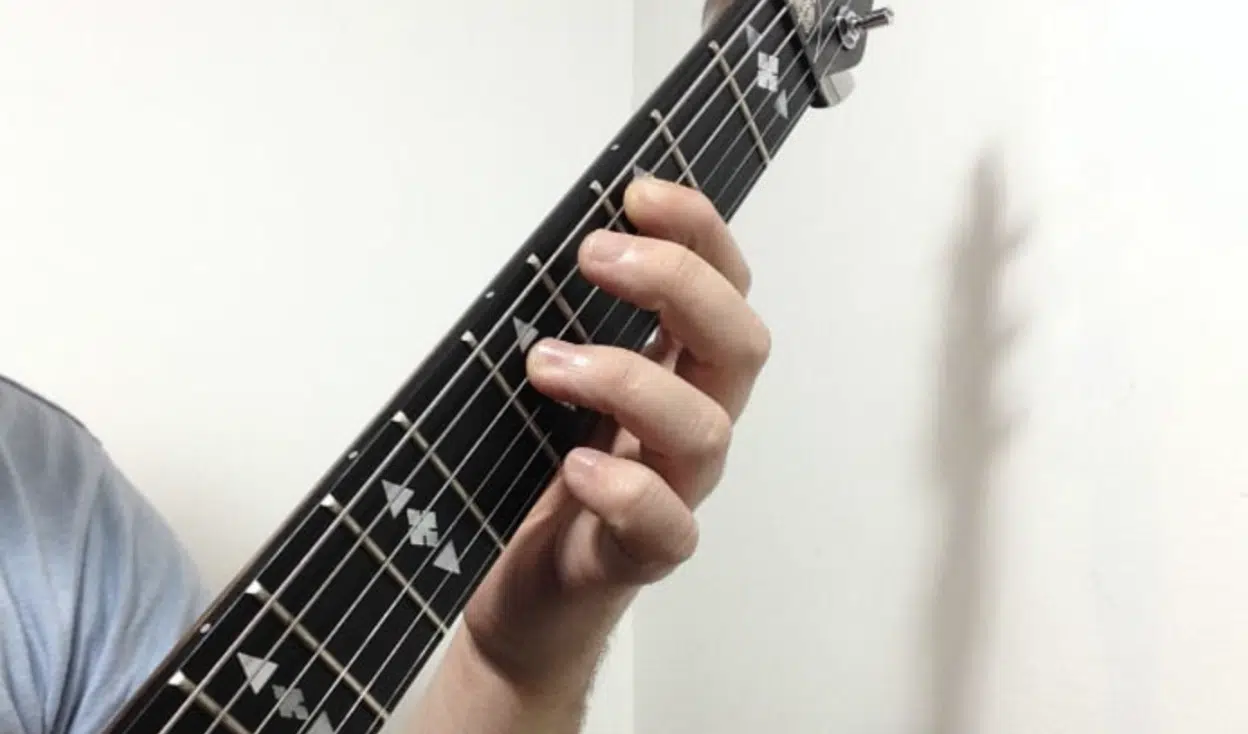
Using power chords in combination with single notes can help you create a fuller sound, especially when you want to really show off a main riff.
For example, try starting a riff with a few single notes and then follow up with a power chord to emphasize a key part of the chord progression.
This technique works well for creating a “call and response” effect within the riff which really makes it more engaging for your listener.
When you want to emphasize a main riff, alternating between single notes and power chords helps add weight and impact without making the riff overly complex.
Pro Tip: How to Use This Technique
- Start with single notes: Play the E (open low E string) once, followed by a quick hammer-on to the G (3rd fret, low E string), and then a slide up to the A (5th fret, low E string).
- Add power chords: After playing the single notes, hit the E5 power chord (open E + 2nd fret A string) to emphasize the start of the riff.
- Alternate back to single notes: Go back to the G (3rd fret, low E string) as a single note and follow it with the G5 power chord (3rd fret E + 5th fret A).
- Finish with power chords: End the riff by playing the A5 power chord (5th fret E + 7th fret A) twice, creating a rhythmic, punchy ending.
If you’re a guitar player wanting to really master creating a great guitar riff, any of these techniques can make it more dynamic and engaging, which is what you want.
Expert Tips for Working with Guitar Riffs Digitally
When working with guitar riffs digitally, there are some advanced techniques you can use to make them sound professional and polished. So let’s discuss a few of my favorite ways to help you maximize your guitar part/guitar sections (for all my digital producers).
-
Layering Techniques for Virtual Guitars
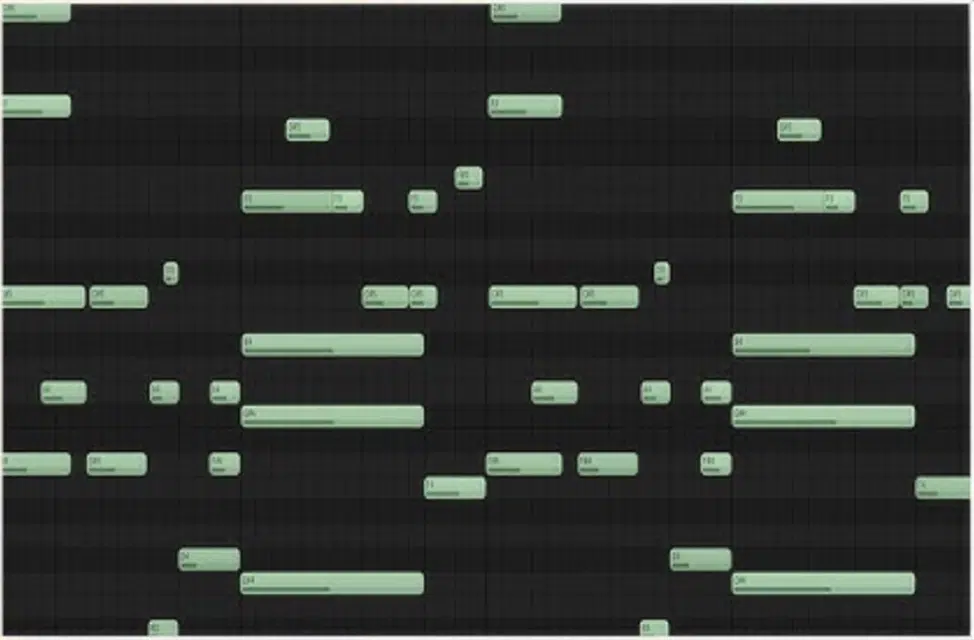
When layering virtual guitars, it’s important to use different tonal characteristics for each layer to create a sense of space and depth.
For example, you can start by recording/using a guitar riff with a clean tone, then duplicate it with a slightly distorted version to add some grit.
You might pan the clean guitar 30% to the left and the distorted one 40% to the right to avoid frequency overlap, which can create a wide stereo field.
Also, you can adjust the EQ on each track, cutting low mids (around 250-400Hz) on one layer while boosting the high frequencies (around 3-4kHz) on the other.
This will make sure each unique layer occupies its own frequency range and the riff doesn’t sound cluttered, amateur, or straight up ridiculous.
-
Using Effects to Enhance Digital Guitar Riffs
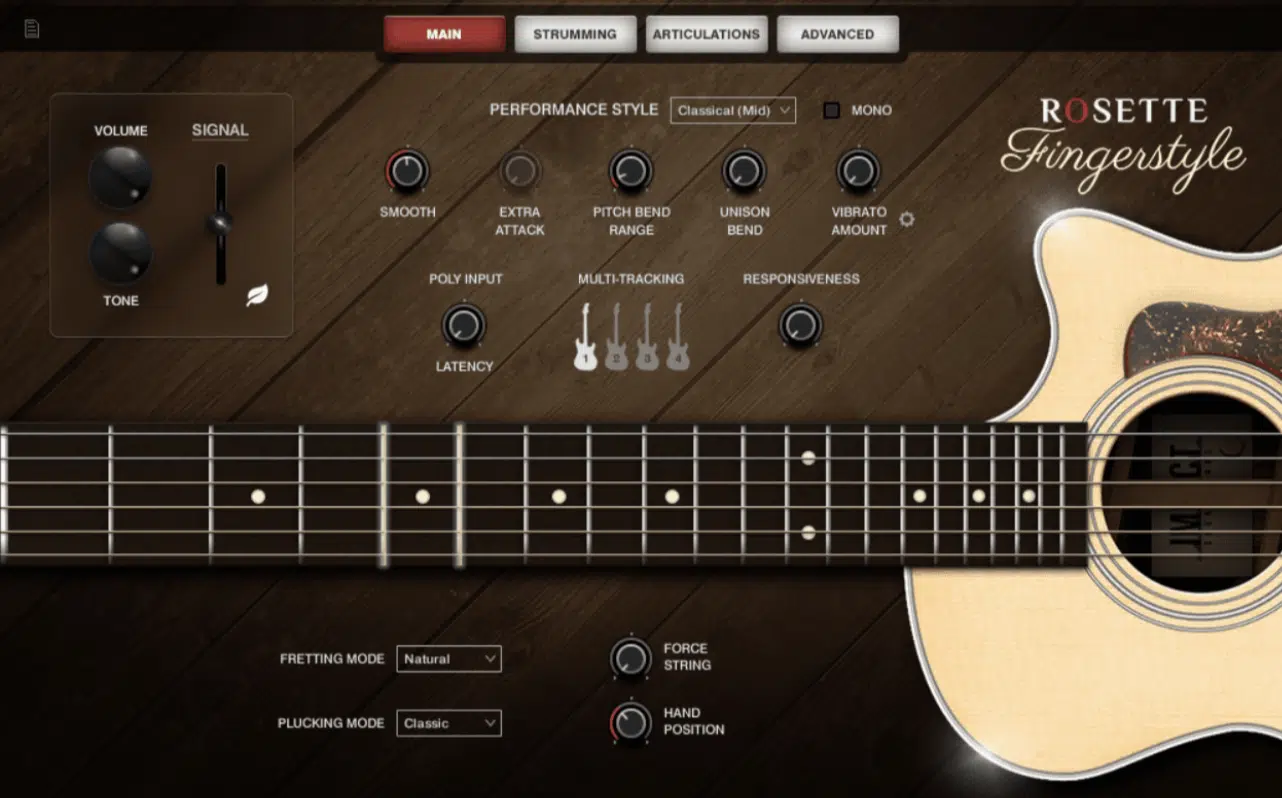
Adding effects like delay or distortion can take your digital guitar riffs to the next level by giving them extra character and presence in the mix.
For example, try using a delay set at 1/4 note to create a rhythmic echo that complements the tempo of your riff without overcrowding the mix.
You can also use distortion to add some crunch to your guitar, but set the drive to a moderate level (around 40-50%) so it doesn’t overwhelm the natural tone.
This is especially true if you’re layering the guitar with cleaner tones because things can sound unnatural very quickly.
To give your riff more depth, apply reverb with a decay time of around 2.5 seconds, but make sure the wet/dry mix stays around 20-30% to avoid washing out the guitar.
-
Integrating Riffs into a Full Track
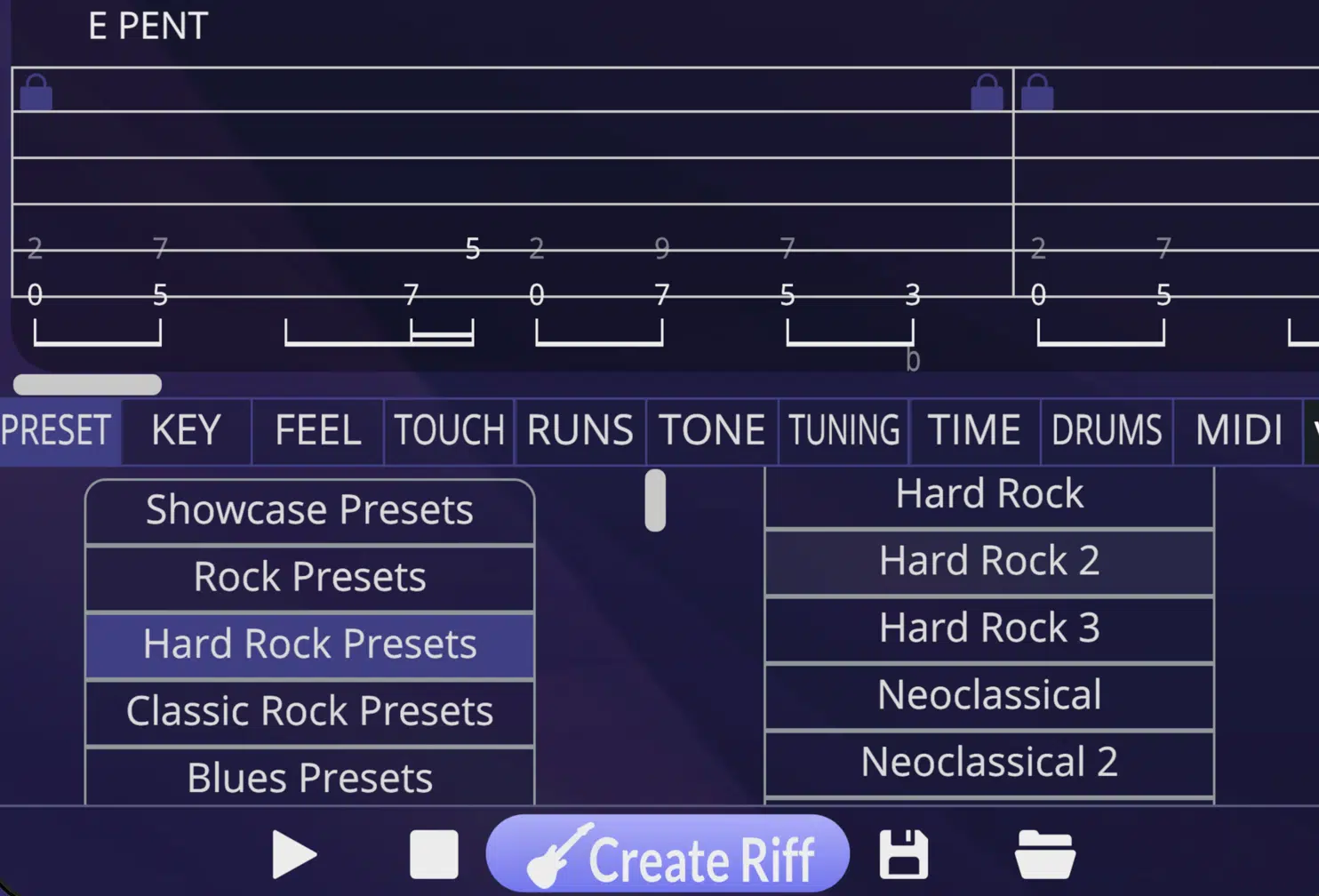
To successfully integrate a guitar riff into a full track, you have to consider how it will interact with the rhythm and harmony of other elements like the bass and drums.
For example, you can have the riff play during the verses with minimal layering, then stack it with additional layers or effects during the chorus to create a dynamic shift.
If you’re working with a bass riff, try cutting some of the low-end frequencies from the guitar track (using a high-pass filter at 150Hz) to avoid clashes.
And, maintain clarity between the instruments, of course.
You can also use automation to slowly increase the reverb or delay on the guitar riff during the bridge or outro to give the track a more spacious, evolving feel as it progresses.
-
The Best Tools for Laying Down Guitar Riffs
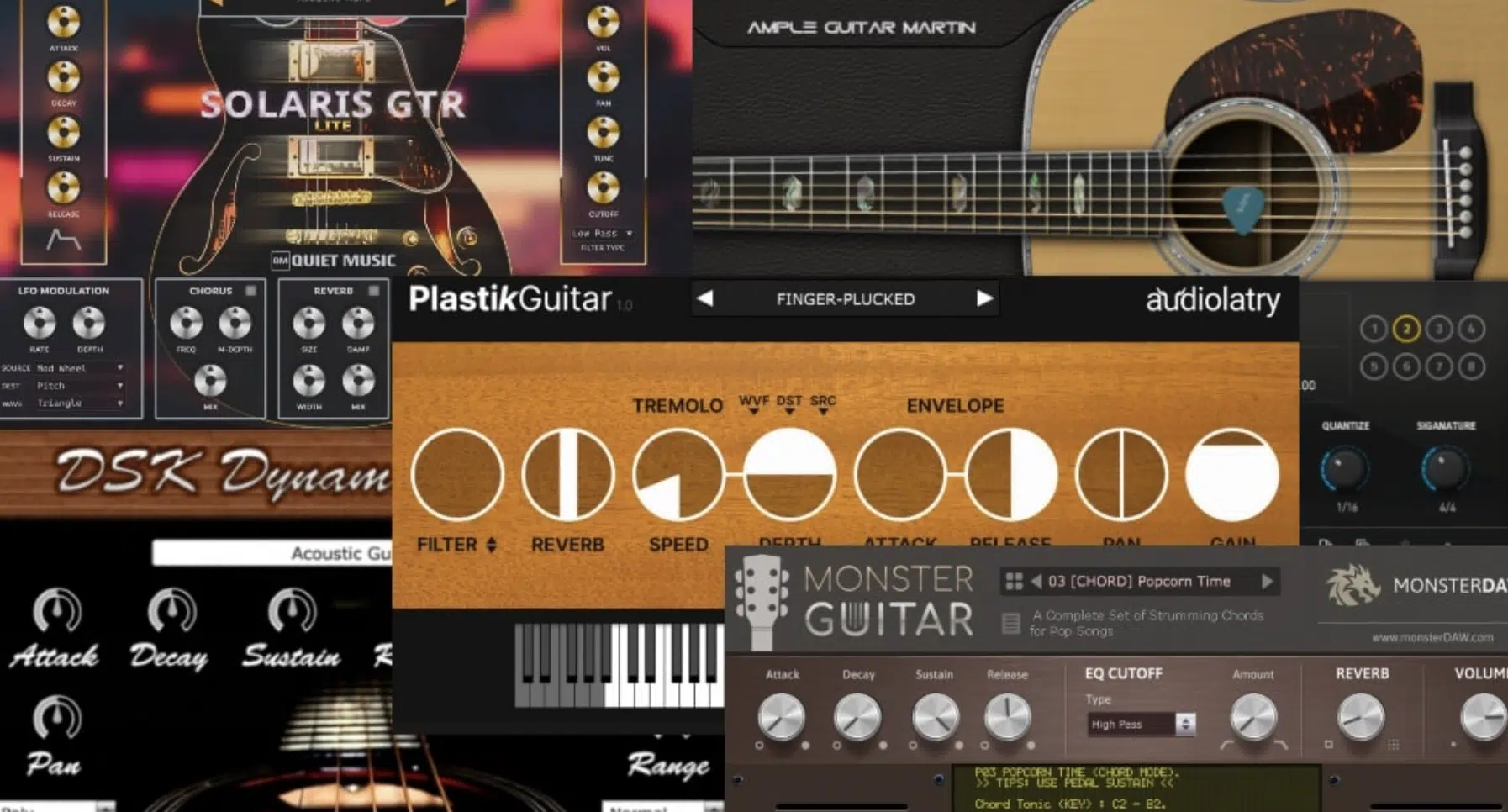
Using the right digital tools can greatly enhance the quality and flexibility of your guitar riffs in so many intriguing and show-stopping ways.
If you’re using a plugin like Guitar Rig, you can experiment with amp simulations; try starting with a British-style amp model for a classical music rock tone.
To dial in a warmer tone:
- Set the gain around 60%
- Adjust the mid-range frequencies to about 65%
- Boost the treble to 70% for added clarity
If you want a more melodic edge, add a touch of reverb with a decay time of 2.5 seconds and a mix level of 20% to give the guitar riff a sense of added space.
Another great tool is MIDI guitar plugins, where you can trigger virtual guitar sounds using a MIDI controller/MIDI keyboard.
This allows for easy tweaking, like changing the chord progression or adjusting the velocity of each note to simulate real-life playing dynamics.
For example, start by setting the velocity of your main guitar riff between 90-100 for accented notes, and lower it to around 70 for softer, more subtle notes.
NOTE: You can also experiment with pitch bends and modulation controls on your MIDI controller to add expression to make your guitar sound more realistic.
I like to add a cabinet simulation plugin after my amp simulation to get that full-bodied, realistic guitar sound, which works great.
For instance, choose a 4×12 cabinet model with mic positioning set closer to the speaker cone to capture the sharpness of a guitar riff.
Or, position it toward the edge for a warmer, rounder tone; dealer’s choice.
Just make sure to adjust the mic placement virtually to find the sweet spot 一 giving the riff the punch and body it needs to stand out in the mix.
And the best part about working in today’s world is, no musical idea is too crazy, so you can push boundaries all day (like I love to do).
You could even layer multiple amp sims together or run a guitar riff through unexpected effects like flangers, phasers, or even granular processors to create magic.
Side note, if you want to discover the best free guitar VSTs in the game, we got you.
The 9 Best Guitar Riffs in History
Throughout rock music history, there have been great examples of how powerful and iconic guitar riffs can be in rock and other genres. Below, we’ll dive into some of the most memorable riffs ever created, breaking down what makes them stand out and why they’ve become such an essential part of popular music.
#1. “Smoke on the Water” by Deep Purple
“Smoke on the Water” by Deep Purple, written by Ritchie Blackmore, is the perfect example of a guitar riff that is not only simple but also incredibly powerful.
When it comes to popular riffs and lovely examples, this one takes the cake.
It’s built on just a few single notes, yet it’s repeated multiple times throughout the song 一 making it one of the most immediately recognizable riffs in rock music.
The secret to its staying power lies in the use of parallel fourths, a technique where two notes are played together.
This creates a harmonized, gritty sound that works perfectly in the context of hard rock.
When you’re trying to recreate a guitar riff with this level of impact digitally, you might want to experiment with layering slightly different tones.
For example, you use one clean guitar sound and one with mild distortion, then pan each one to opposite sides to mimic the effect of a live recording.
This riff is a great example of how less can be more when it comes to creating guitar riffs for your own rock song.
Remember, no musical idea when it comes to what is a riff in music is impossible.
#2. “Sweet Child O’ Mine” by Guns N’ Roses
The main riff in “Sweet Child O’ Mine” is a classic example of a guitar riff that blends a catchy phrase (melodic) with rhythmic precision.
This great riff starts with a repeating sequence of single notes that gives it a flowing, almost vocal-like quality, which makes it stand out in the realm of popular music.
If you’re creating a similar guitar part digitally, try using a guitar plugin that simulates a warm, slightly overdriven tube amp.
Remember to set the gain around 40% to capture that smooth, clean tone.
You can also adjust the attack of each note to make the riff feel more natural, making sure that it syncs well with the rhythm of your track.
#3. “Smells Like Teen Spirit” by Nirvana
“Smells Like Teen Spirit” features a guitar riff that captures the raw energy of grunge while still being structured enough to hook the listener in.
The riff is based on simple power chords and a repeating rhythm so it’s super easy to play, yet is still incredibly effective.
When recreating a guitar riff with this kind of punch, set your amp plugin’s distortion to a higher gain (a good example is around 70-80%) to achieve that gritty, aggressive sound.
NOTE: As I mentioned before,keep the chord progression simple and repetitive to create a groove that grabs attention.
Make sure the bass and drums lock in with the guitar riff to create a unified sound in your mix that will make things sound professional.
#4. “Enter Sandman” by Metallica
The guitar riff in “Enter Sandman” is a classical music example of how to use repetition to build tension and energy within a rock song or whatever genre you’d like.
This memorable riff is driven by a palm-muted rhythm, which creates a percussive feel, locking in with the bass and drums.
To recreate this effect digitally, you can set your amp plugin to a high-gain setting (around 75-80%) while dialing back the treble to about 50%.
This will give you a darker, more aggressive tone that is really interesting.
A helpful tip is to automate the volume of the guitar riff to slowly increase as the song progresses, making it feel more intense as it builds toward the chorus.
This technique ensures your riff cuts through without overpowering other elements in the mix, especially the vocal line.
#5. “Mannish Boy” by Muddy Waters
In “Mannish Boy,” this memorable riff shows off the simplicity and impact of a repetitive blues pattern.
It’s built on a single-note motif that serves as a call-and-response with the vocal line (refer to the call-and-response we talked about earlier).
Great riffs like this are heard throughout history, so make sure to check it out to get a better reference of what you should be aiming for when it comes to realism.
If you’re looking to create a similar blues riff digitally, start with a clean guitar tone…
Then, use a compressor plugin to tighten the dynamics, setting the threshold around -10dB with a ratio of 4:1 to keep the attack snappy.
To enhance the feel of live playing, use a light amount of reverb (10-15% wet/dry mix) to give the guitar a natural room sound.
The repeated riff in this track shows how minimalism, when used the right way, can create a powerful groove without the need for complex chord progressions.
This solo improvisation is one of the most epic variations ever, so check it out.
#6. “Seven Nation Army” by The White Stripes
The guitar riff in “Seven Nation Army” is an example of how a repeated riff can hold down an entire musical composition and become iconic through sheer simplicity.
The main riff is played on a guitar but processed to sound like a bass line using a pitch shifter effect as we touched upon earlier.
If you’re working digitally, you can easily recreate this by using a pitch shifter plugin, setting the pitch an octave lower to simulate a bass guitar.
Also try boosting the lower frequencies (around 80Hz) while slightly cutting the high mids (around 2kHz) to give the riff that bass-like punch.
This guitar riff is a great example of how tone manipulation can transform a basic melodic idea into something unique and instantly recognizable.
#7. “Satisfaction” by The Rolling Stones
“Satisfaction” by The Rolling Stones features one of the most iconic guitar riffs in rock music history, created by Mr. Keith Richards himself.
The riff itself is a repeated figure played with a fuzzy, overdriven tone that gives it a distinctive edge people love.
If you’re trying to replicate this, a fuzz pedal plugin with the gain set to about 60-70% will help capture the rawness of the original sound.
Make sure to adjust the EQ to boost the mids (around 1-2kHz) to give the guitar riff more presence in the mix.
This is a great example of how a simple, catchy guitar part can carry an entire rock song with minimal layering or complexity.
Pro Tip: When working with this type of guitar riff digitally is to use a compressor with a threshold of -10dB and a ratio of 4:1 to maintain consistency across the riff.
You’ll get a repeated figure that captures the raw energy of the Rolling Stones while maintaining clarity in the mix; something that has helped the Rolling Stone sound remain timeless.
#8. “Whole Lotta Love” by Led Zeppelin
In “Whole Lotta Love” by Led Zeppelin, the guitar riff is a great example of how to use rhythmic spacing and power chords to build tension within a track.
It alternates between short bursts of notes and rests so the rhythm section can breathe and the overall groove gets enhanced perfectly.
When working digitally, you can achieve a similar feel by using precise timing in your DAW, setting the riff to match the exact grid of the tempo.
Just make sure to add subtle variations in velocity to simulate the dynamics of live playing because you don’t want things to sound unnatural.
Try using a distortion plugin with a gain setting of around 65% and a light reverb effect with a decay of 1.5 seconds to give your guitar a full, resonant sound without overwhelming the other instruments/other main instrumental part.
It’ll help maintain clarity in the mix while allowing the guitar part to dominate during key sections like the chorus.
#9. “Rebel Rebel” by David Bowie
The guitar riff in “Rebel Rebel” is one of the most recognizable riffs in pop music, defined by its catchy, repetitive nature.
When it comes to popular riffs, this one is certainly up there.
If you’re working digitally, try starting with a bright, clean tone and adding just a touch of overdrive to give it an edge without losing clarity (gain around 30%; treble at 70%).
The repeated sequence of notes in this riff relies on the consistency of the rhythm.
So, be sure to keep the timing tight by quantizing your guitar part in your DAW to align perfectly with the track’s tempo.
NOTE: You can layer the guitar with subtle stereo widening effects 一 panning duplicate tracks left and right to create a fuller, more immersive sound in the mix.
What is a Riff in Music: Final Thoughts
When you’re learning what is a riff in music, it’s really all about understanding the role of repetition, rhythm, and dynamics in shaping the feel of a song.
Learning how to create guitar riffs that stand out means mastering specific techniques like palm muting, hammer-ons, and power chords.
And for my digital producers, understanding how to apply and manipulate the right tools to help your guitars sound authentic and appealing.
Plus layering different tones, utilizing effects creatively, and integrating riffs into full arrangements like an absolute boss.
This way, your tracks will have that extra punch, and you can successfully drive the groove of any song with razor-sharp precision.
Make sure to use the tips, tricks, and techniques we covered to knock out some of the sickest riffs in the game (whether physically on your guitar or digitally in your DAW).
As a bonus, if you’re looking for the best Free Guitar Loops, we got you covered.
This legendary free pack includes 10 high-quality guitar loops 一 both processed and dry versions, along with 40 matching MIDI stems.
These loops are designed for flexibility and can work with a wide range of genres like hip-hop, pop, and rock.
And yes, they’re all 100% royalty-free so you can freely use them however you’d like.
It provides everything from classic electric guitar sounds to smooth acoustic tones, so when it comes to working with professional riffs, it has everything you’ll need.
With these new skills and resources you’re ready to create guitar riffs like a true professional, just remember the best ones are simple yet extremely impactful.
So, keep practicing, stay creative, and don’t EVER be afraid to push boundaries.
Until next time…







Leave a Reply
You must belogged in to post a comment.